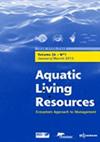土耳其凡湖盆地特有物种塔利克(Alburnus tarichi)的遗传多样性和种群结构
IF 1.9
4区 农林科学
Q3 FISHERIES
引用次数: 0
摘要
本研究利用9个微卫星位点,对土耳其东部凡湖盆地18个种群804份塔利克(Alburnus tarichi)样本的亲缘关系进行了研究。共检测到93个等位基因,平均每个位点的等位基因数为10.3±3.39个。观察杂合度和期望杂合度均值分别为0.340±0.016和0.362±0.015,多态性水平较低。经Bonferroni修正(P <;0.0027), 18个群体中有12个群体处于Hardy-Weinberg平衡(HWE) (P = 0.0120 ~ 0.9981)。分子方差分析(AMOVA)显示,个体间遗传变异大于76%,群体间遗传变异大于19%,显著高于零(FST = 0.19),群体内个体间遗传变异较低(FIS = 0.06, FIS = 4.84%)。贝叶斯聚类分析表明,总遗传变异可分为3个聚类。此外,显著性检验结果显示,由于最近的瓶颈事件,18个种群中有11个面临灭绝的威胁。基于微卫星信息,凡湖盆地的塔雷克种群可以划分为不同的遗传群。此外,我们的研究结果为制定保护大尾鳕遗传多样性和实现可持续渔业的管理计划提供了重要信息。本文章由计算机程序翻译,如有差异,请以英文原文为准。
Genetic diversity and population structure of Tarek (Alburnus tarichi), an endemic species to the Lake Van basin, Turkey
In this study, the genetic relationships of 804 tarek (Alburnus tarichi) samples from a total of 18 populations, including the potamodromus and resident individuals from Lake Van basin in eastern Turkey, were studied by using nine microsatellite loci. A total of 93 alleles was detected, and the average number of alleles per locus was 10.3 ± 3.39. The mean estimated observed and expected heterozygosity were 0.340 ± 0.016 and 0.362 ± 0.015, respectively, which indicated a low level of polymorphism. After Bonferroni correction (P < 0.0027), the multi-locus test applied to each population revealed that 12 out of 18 populations were in Hardy-Weinberg equilibrium (HWE) (P = 0.0120–0.9981). Analysis of molecular variance (AMOVA) showed more than 76% genetic variability within individuals and 19% among populations, which was significantly higher than zero (FST = 0.19), and furthermore, a low level of genetic variation was observed among individuals within populations (4.84%: FIS = 0.06). Bayesian clustering analysis indicated that the total genetic variation grouped into 3 clusters. Additionally, the significance test results revealed that 11 of the 18 populations are threatened with extinction due to recent bottleneck events.We conclude that the tarek populations from the Lake Van basin can be classified into distinct genetic groups, based on microsatellite information. In addition, our results provide essential information for the development of a management plan that conserves the tarek's genetic diversity and achieves a sustainable fishery.
求助全文
通过发布文献求助,成功后即可免费获取论文全文。
去求助
来源期刊

Aquatic Living Resources
农林科学-海洋与淡水生物学
CiteScore
2.30
自引率
0.00%
发文量
10
审稿时长
>24 weeks
期刊介绍:
Aquatic Living Resources publishes original research papers, review articles and propective notes dealing with all exploited (i.e. fished or farmed) living resources in marine, brackish and freshwater environments.
Priority is given to ecosystem-based approaches to the study of fishery and aquaculture social-ecological systems, including biological, ecological, economic and social dimensions.
Research on the development of interdisciplinary methods and tools which can usefully support the design, implementation and evaluation of alternative management strategies for fisheries and/or aquaculture systems at different scales is particularly welcome by the journal. This includes the exploration of scenarios and strategies for the conservation of aquatic biodiversity and research relating to the development of integrated assessment approaches aimed at ensuring sustainable and high quality uses of aquatic living resources.
 求助内容:
求助内容: 应助结果提醒方式:
应助结果提醒方式:


